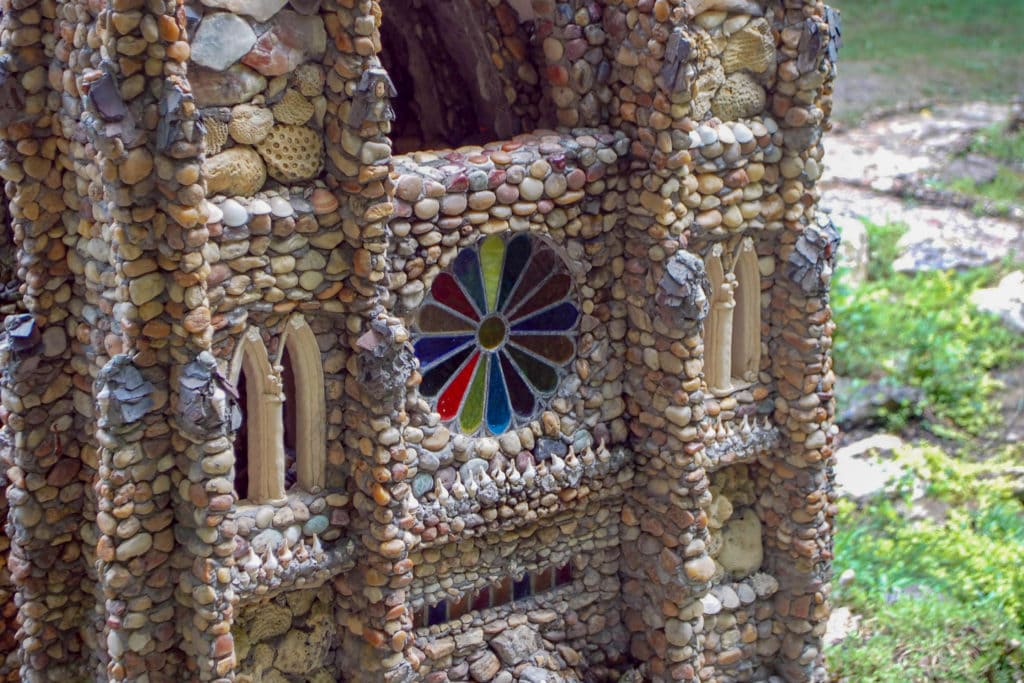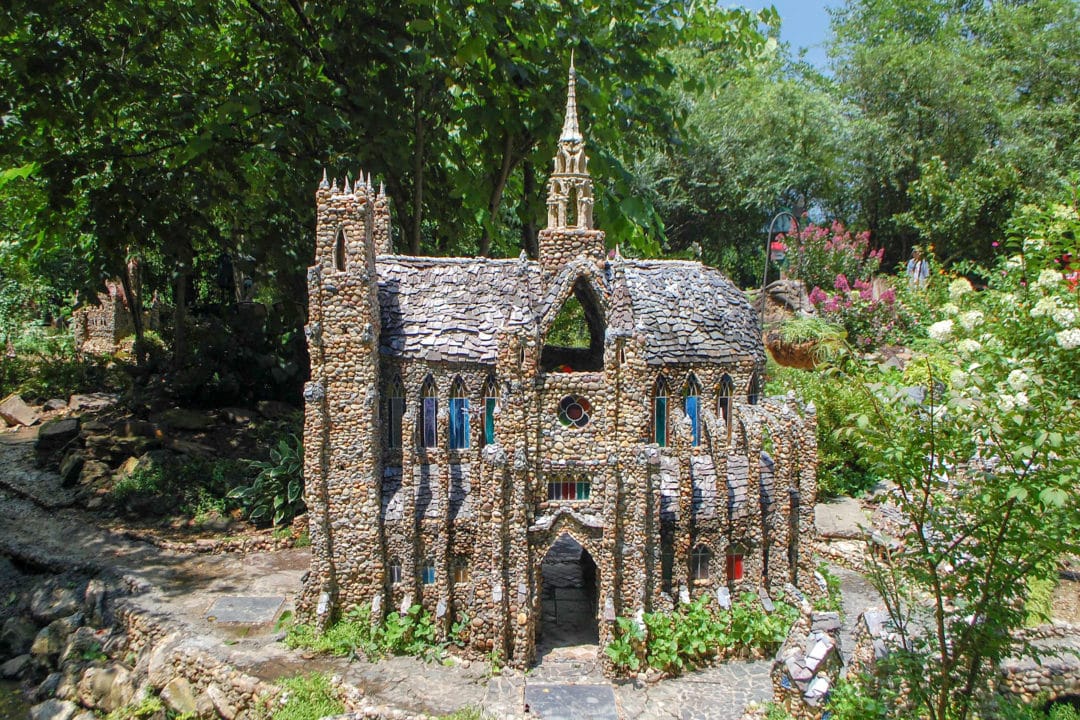I almost drive by it. The Rock Garden in Calhoun, Georgia, is invisible from the road, hidden in a grassy valley behind a church. It’s the kind of place you’d never know was there unless you were looking for it.
Fortunately, I am. It’s the sole purpose of my trip into rural northwest Georgia, where I heard there was a thriving miniature stone village off the highway. And as I head down toward a creek, I see it—a collection of castles, courtyards, bridges, and cathedrals, each just a few feet tall, cobbled together from pebbles, shells, bits of ceramic, and concrete.
There’s a replica of Notre Dame, with stained glass, lancet windows, and flying buttresses. There’s the blue-domed town of Bethlehem, Japan’s Himeji Castle, and Camelot. The village is laid out in somewhat haphazard geography with small and sometimes obscure handmade signs identifying the different pieces, but that just encourages a closer look.
“I loved it from the minute I stepped into it,” says Brandy Long, who lives nearby and helps maintain the site. “It blew me away, all of the intricacies and the details. It was this enchanted place, like a secret garden.”




A garden game
Long started volunteering at the rock garden last summer, apprenticing along with her kids under DeWitt Boyd—the artist who created it—or “Old Dog,” as everyone calls him.
“We clicked right away,” Long says. “Almost every day, we would come to the garden. He showed me how to add the rocks to the cement. You have to do it in a very specific way. Once he saw that we could do that, he started me on bigger things, like pillars and bridges, teaching me how to make a foundation strong. He said he was teaching me because he knew eventually repairs would have to be made.”
The rock garden wasn’t originally intended as a roadside art installation. For a while, it was simply Old Dog’s hobby, inspired by a game he used to play with his kids.
“He would sculpt a few buildings, group them together into a town, add little handcrafted people, and use that to teach his kids about things like buying and selling and being a good neighbor,” Long says. “Even after they grew up, he loved building, so he asked the Calhoun Seventh-Day Adventist Church if he could build on their land, and they said yes.”

That was in 2007. Since then, the tiny buildings have sprawled across nearly an acre of land. Volunteers have added a gazebo, picnic tables, and seasonal flowers.
“There never was a master plan for the garden,” explains Jan Miller, a member of the church who, along with her husband Mike, oversees the garden. “It just evolved over the successive years.” The couple worked with Old Dog on the garden for almost six years before he moved away last year.
“He kept building, and it grew,” Miller says. “At first, it was just little buildings, then the tall seaport building that’s sometimes surrounded by water, then the Castle of Rejoicing. Most took over a year to build. We wanted this to be a place of prayer and peace.”
If you build it
Soon, more people started coming, some to meditate and pray, but most just to marvel at the unusual folk art. Travelers from across the country would hear about it and stop by Calhoun. Meanwhile, the village kept growing. Miller estimates that the village contains about 50 structures in all, including a monastery, lighthouse, enclosed prayer garden, several castles and bridges, the historic town of Nottingham, and part of Paris.

To help visitors, the church created a map to the sites. Not all of them, Miller says, since they’ve never actually counted, but the big ones: the Colosseum, Castle of Angels, Dover Castle, and about 20 others.
Wandering the garden is something of a scavenger hunt, searching for the details that make each piece unique, such as mosaic terraces of colored stones or engraved tile floors inside of a cathedral. In one top-story room, I find a dog no larger than my thumb curled up on a pillow. Long tells me there’s supposedly a green dragon in one of the towers, but she’s not sure where.
The wall of the prayer garden conceals another treasure. Several hearts and plaques embedded in the rock bear the names of couples who’ve married in the garden. One of these reads “Old Dog and Lady Joyce.”
“It’s a really sweet love story,” Long says. “They met and married right here at the Calhoun Rock Garden. She was one of the first volunteers, and they worked together for eight years before marrying. Afterward, they kept right on building together.”
Growing and glowing
With the artist out of state, Long is the only one who knows the precise method for turning pebbles, cement, and 14-gauge chicken wire into village material, though she’s teaching the Millers how to do it. The three are currently working on repairing a bridge that was damaged by a falling tree limb.
The garden is now fully managed by volunteers, but according to Long, that’s as it should be.
“Old Dog always loved people stepping in to help out,” she says. “He told me that the garden has a way of bringing people together. He said, ‘This isn’t just my garden or Joyce’s garden or the church’s garden. I want this to be a part of everyone.’ Luckily, we have a lot of really goodhearted people here who love what the garden stands for.”

The community celebrates that love each year with an illumination ceremony, usually held in October. Volunteers light lanterns and hang them on the posts above the walkways, and children who attend are invited to place hundreds of candles around the garden—in windows, on ledges, in candle holders built into the bridges—until the whole village is ablaze.
Next year, Long hopes a new piece will be part of the illumination. On a small hill behind the Colosseum sits an unfinished replica of Jerusalem, started last year. When it’s completed, it will feature myriad doorways, staircases, and roofs, all encircled by a wall.
“The wall hasn’t been built yet. These things take time,” Long says, adding that they’re not yet a quarter of the way through. But like the rest of the garden, seeing the artwork take shape, stone by stone, is part of its charm.
If you go
The Calhoun Rock Garden is open daily from dawn to dusk.









